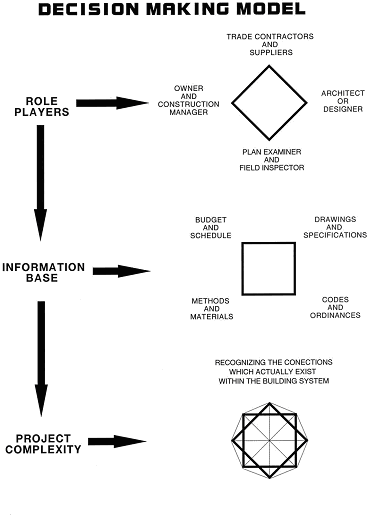
Nothing is more difficult, and therefore more precious,
than to be able to decide. - Napoleon
Every residential construction project eventually becomes a home where families celebrate holidays, birthdays, graduations, and retirements. The ultimate goal of the Design/Build process is to create a homestyle to match a family's lifestyle. For this reason, the Owner should be at the center of all decisions.

Each construction professional-Construction Manager, Architect, Trade Contractors, Suppliers, Plan Examiner, and Field Inspector-should dedicate their activities toward serving the Owner's best interest.
There are a variety of roles to be played on the construction stage, and the Owner's vision as project director is the guiding influence for everyone's performance. A listing of the principal players will help orient Owners to the cast of characters:
Real-Estate Agent
These professionals are responsible for assisting Owner in buying and selling land, and usually coordinate various aspects of the closing when the property deed is transferred.
Construction Lender
These professionals are responsible for lending money to the Owner to purchase land and/or the house; most often, the land and house are used as security until the loan is paid in full.
Construction Manager or General Contractor acting as CM
These professionals are responsible for assisting Owner in planning, organizing, and controlling the Design/Build process to ensure Owner's best interest is maintained from start to finish.
A great option is to hire a General Contractor to act as your Construction Manager under a Personal Service Agreement; in this way, you benefit from his/her connections to the industry but s/he may be involved as little or as much as you deem necessary!
Architect/Designer
These professionals are responsible for creation of Drawings and Specifications following requirements provided by Owner orienting house and site to family lifestyle prior to and during construction.
Civil and Structural Engineers
These professionals are responsible for providing scientific knowledge to solve construction problems related to geological and structural conditions during creation of Drawings and Specifications.
Specialty Trade Contractors
These professionals are responsible for providing trade labor and bid proposals at each phase of construction adhering to Drawings and Specifications, and accountable directly to the Owner.
Suppliers and Manufacturers
These professionals are responsible for providing material and products at each phase of construction adhering to Drawings and Specifications, and accountable directly to the Owner.
Plan Examiner and Field Inspector
These professionals are responsible for reviewing Design/Build criteria both prior to and during construction process to maintain compliance with applicable codes and ordinances in your area.
The Owner may act as the General Contractor playing the role of leader to the entire construction organization. With the possible assistance of a Construction Manager, the Owner contracts all activities in order to save money, maintain standards for quality, and provide personal attention to all phases of the Design/Build process.
So, you want to be your own general contractor? To determine whether or not you have what it takes to be an Ownerbuilder, ask yourself these questions:
- Do I have the time to dedicate 10-20 hours a week to my job each week?
- Am I tenacious enough to communicate effectively with professionals when we disagree?
- Can I make decisions quickly and confidently?
- Am I a good planner who remains organized from the beginning to the end of a project?
If you've been honest with yourself and answered yes to these questions, then you may have what it takes to be an Ownerbuilder. If not, then you should definitely follow the more traditional route of hiring a General Contractor for your home building or remodeling project...
...or you can hire the GC to act as your Construction Manager under a Personal Service Agreement.
The DECISION MAKING MODEL illustrates how the decision making process shifts from the simple desire of the Owner to create a new home to utilizing the complex information base of the construction industry. Each professional provides specialized information to the Owner from years of education and experience to create the best results possible for the decisions to be made. All information is interdependent as each role player relies on the other for guidance during the Design/Build process.

Although an optimistic "can do" attitude by the Owner is to be admired, one should be mindful that the existence of these various roles and specialized bodies of knowledge is born of necessity. Defining the requirements of your lifestyle, generating Drawings and Specifications, determining a Budget and Schedule, and locating Trade Contractors and Suppliers are overwhelming tasks, which may be considered shared responsibilities in order to simplify decision making.
Decision making begins early in the Design/Build process so make every effort, if necessary, to collaborate with a Construction Manager, Architect, Engineer, Suppliers, Trade Contractors, Lawyer, or Accountant. Be aware of the "systemic" qualities of Project Management; in other words, all parts of residential construction comprise a unified whole.
For instance, where one locates their home on site determines logistics for material delivery and utilities layout. A terrific location may become a logistical nightmare, or, worse yet, denial of a building permit. By recognizing the connections which actually exist within the building system, the Owner accepts the roles of the various players, the contributions they make, and proceeds cautiously when decision making.
Another consideration for the Owner is how to record information throughout the Design/Build process in order to make decisions efficiently and effectively. The choice is between a manual or automated system for information storage and referral. A manual system relies on manila files, checklists, and a traditional use of paper and pencil techniques. An automated system incorporates computer hardware, construction management software, and an electronic approach to information processing.
For the purposes of this guide, the Owner is encouraged to use a manual system. For a one-time use on a construction project, a considerable amount of time will be dedicated to training for and development of a software system geared toward construction management. Rather than expend the time and effort, not to mention hardware and software costs, to develop a proficiency in the use of a software system, the Owner should concentrate on the primary goal of Project Management: to create a homestyle which meets the needs of a lifestyle.
Following a manual approach to information processing allows the Owner to begin immediately with the Design/Build process, analyze the circumstances of the project, and concentrate on decisions which directly relate to Project Management. However, if the Owner is proficient in the use of a PC or MAC computer, by all means, put your keyboarding skills to use but just use the standard desktop functions and browser capabilities that are standard.
For a manual approach, there are several products which will improve the efficiency of decision making. Construction calculators from Calculated Industries are a great way to solve building problems in the feet-inch format when figuring material quantities, unit costs, stair and roof layout, square footage, and volume calculations. The instructions are easy to understand, and the Owner can begin using the calculator immediately.
To augment a manual approach, put to use Microsoft Outlook that's a standard feature on all Microsoft Desktops. Features include a Calendar, Contact Manager, Drafts Folder, Email Inbox/Outbox, Journal, Notes and Tasks. This will be all you need to supplement a manual approach to Project Management. Owners with keyboarding skills easily begin with what they already know and progress into more efficient desktop applications.
The result of supporting a manual system with a construction calculator and Microsoft Outlook creates a hybrid method combining small-scale automated system with traditional paper and pencil techniques. When analyzing and recording information for decision making, the Owner should utilize available technology yet realize the need to get on with the tasks of Project Management.
What's the reason for being a good decision maker? The reason is to overcome the kinds of problems that customarily arise on any project-limited budgets, tight deadlines, conflicting priorities, the complexities of defining project priorities and the difficulties of organizing people with different expertise into an effective team. Be ready to follow these simple best practices when making decisions for your project:
DECISION MAKING ESSENTIALS
#1. Pre-Qualify with your lender.
#2. Know your site before you buy the land.
#3. Plan with a systems view of the whole process.
#4. Build it on paper with a complete set of Drawings & Specifications.
#5. Create community spirit by collaborating with construction professionals.
The Home Building Guide is dedicated to providing the ways and means to help you anticipate problems! The ultimate goal of the Design/Build process is to create a homestyle to match a family's lifestyle.
Don't forget: the Owner should be at the center of all decisions.
| 




